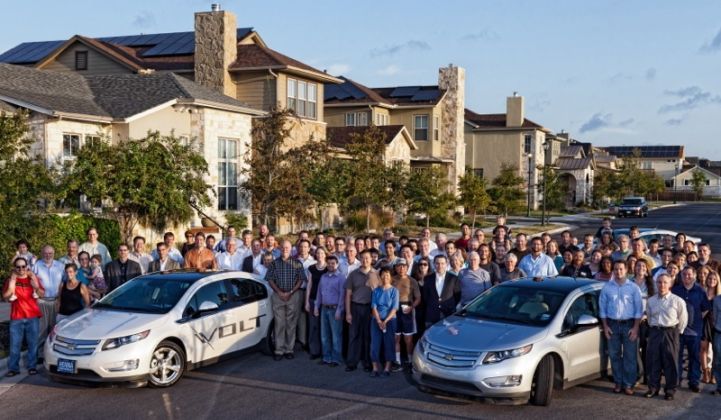Last October, General Motors pledged to make up to 100 Chevy Volt plug-in hybrids available to the Pecan Street Project, the Austin, Texas smart grid integration project that wants to find ways to make car charging, home energy, solar power and the grid play nicely together.
Then, in February, GM’s OnStar service announced it was developing a set of APIs to help utilities and Volt-owning customers manage the way those plug-in cars charge.
On Tuesday, those two projects came together in the form of a pledge from GM to partner with Pecan Street in a real-world test of those APIs to manage the real world Volts now being bought by residents of the Austin neighborhood chosen for the project.
Just how GM and the various Pecan Street partners -- including Sony, Intel, SunEdison, Whirlpool, Best Buy and Toshiba’s Landis+Gyr -- will end up integrating all these Volts and their charging stations has yet to be determined. Nick Pudar, OnStar vice president of strategy and business development, said that details of the project, which also involved University of Texas researchers and many other partners, are still in the development phase.
Still, he laid out a few of the basic concepts that Pecan Street and GM planned to test, including the ability of the utility -- in this case, Austin Energy -- to control charging to help balance the grid, or combining data from home appliances, rooftop solar systems and charging stations to plan when to charge, or dry clothes or run air conditioning, when the solar system is generating the most power.
“We’re going to be leveraging the various smart grid APIs we have, which include demand response, time-of-use rates, renewable energy charging and a broad range of energy-charging data, so we can look at how the whole home ecosystem of charging information can be put to use,” Pudar said in a Monday pre-briefing.
Those APIs are also being tested out in utility pilot projects with utilities including Duke, Progress and DTE Energy. GM hasn’t named developer partners for the OnStar APIs, but its list of plug-in charging pilot project partners includes Tendril for home energy controllers, Comverge for demand response, Google for mobile mapping apps and fleet vehicle testing, and General Electric for demand response integration.
One of the key tests to be undertaken in the Mueller neighborhood of Austin will be how a large number of plug-in vehicles affect the grid in a single neighborhood, Pudar added. So far, about 50 Volts have been sold to neighborhood residents via a special offer of double the existing $7,500 federal rebate, Pudar said.
That’s “approaching a pretty critical mass of vehicles,” he noted -- and lots of plug-in cars in a concentrated geographic area can present particular challenges to utilities trying to make sure their local distribution grid infrastructure doesn’t break down under the strain.
OnStar will also be collecting a ton of data in the project “based on every charging event: what the charge level was at the beginning, what kind of voltage being used, how many trips being taken per day,” Pudar said. “There’s not going to be a shortage of data.”
This is far from the only plug-in car charging project underway, of course. Nissan has partnerships with AT&T, GE and others to link its all-electric Leaf sedans to mobile and plug-in communications, and many utilities are testing out large numbers of plug-in vehicles.
Still, it will be an interesting display of how well utilities and their customers can manage the influx of lots of plug-in vehicles in one place, as well as how well home energy controls, smart solar systems and other such smart grid systems can integrate with them.
After all, even if plug-in vehicles don’t end up being a hit with the general public, it’s possible that certain neighborhoods -- like, for example, Berkeley, Calif. -- could find them popular enough to put strains on the grid sooner rather than later.



